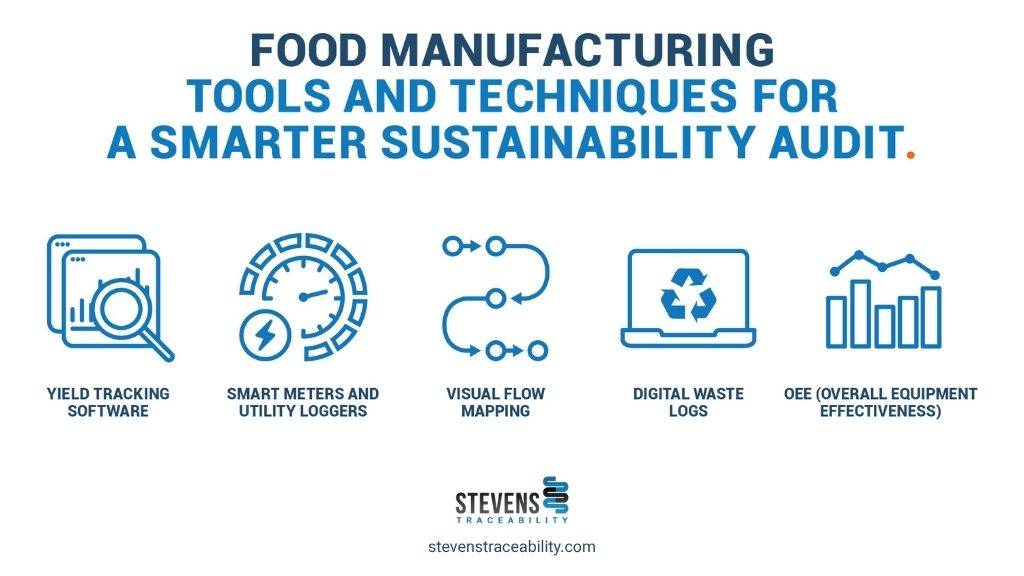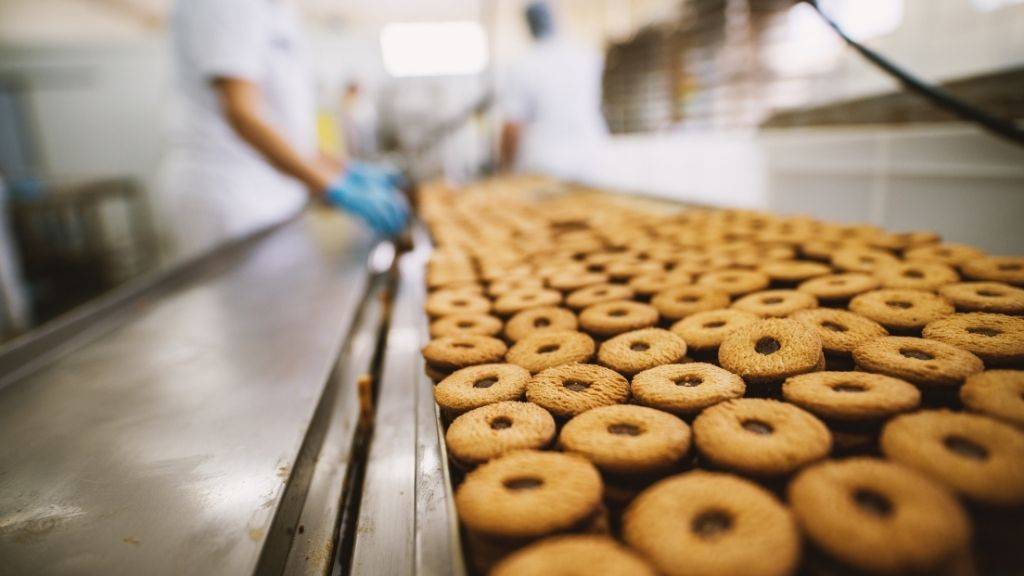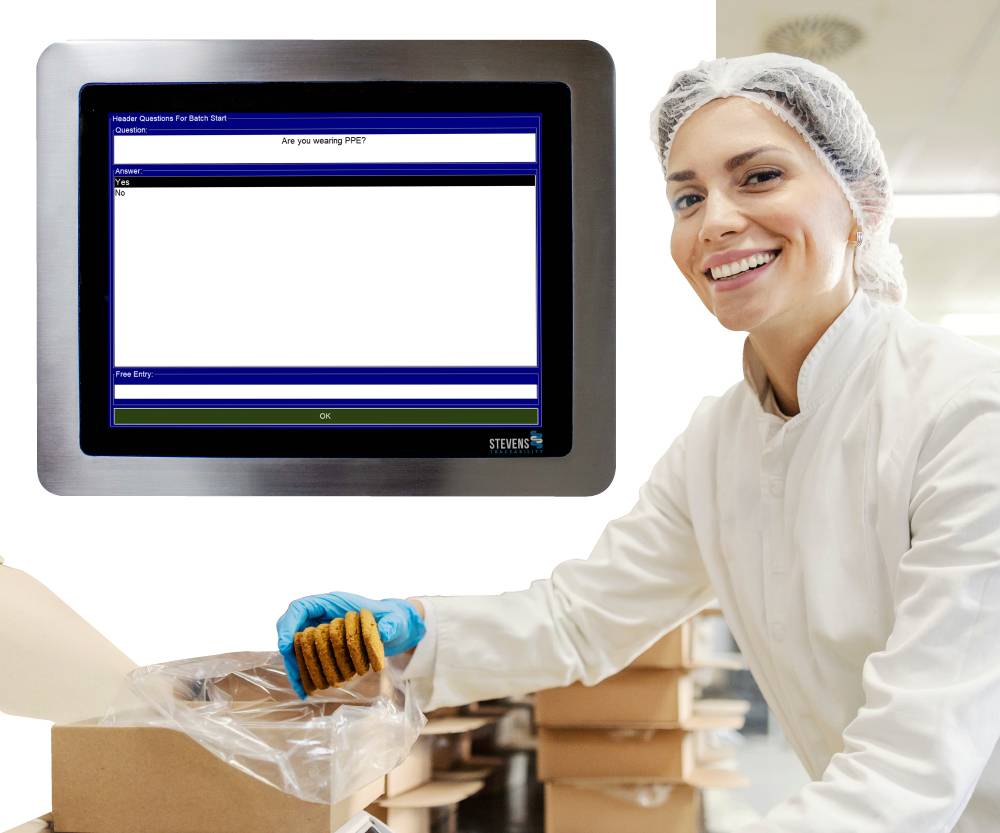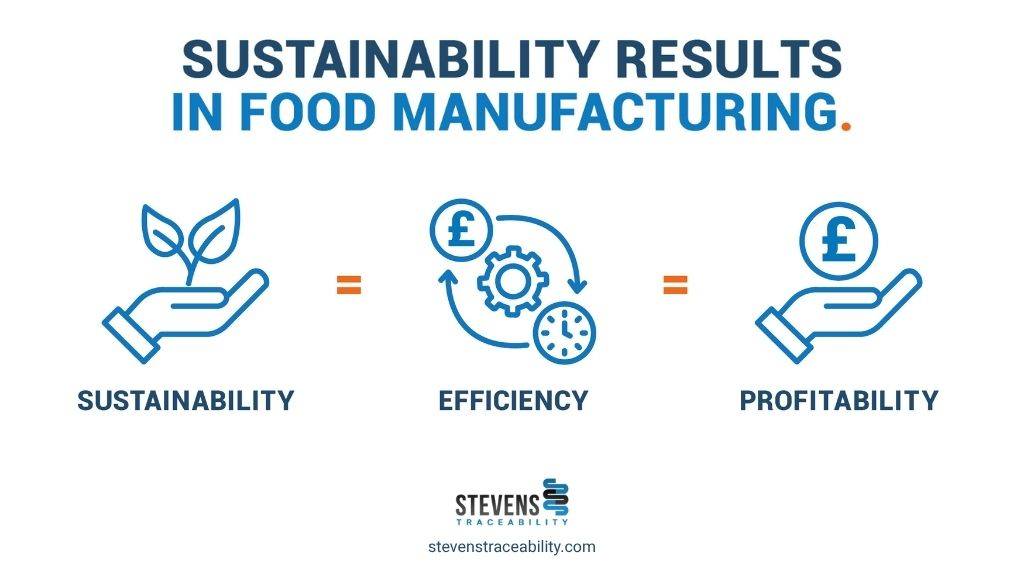Sustainability in food production is no longer a future goal, it’s an urgent operational priority for food manufacturers. Whether driven by rising energy costs, strict environmental regulations, or consumer demand for cleaner practices, the pressure to improve efficiency and reduce waste has never been greater.
According to WRAP (The Waste and Resources Action Programme), over 1.9 million tonnes of food is wasted annually in UK food manufacturing alone much of it preventable. This represents not only a significant environmental concern but also a substantial financial cost.
This article provides practical steps and tools for manufacturers looking to ensure sustainable food production while maintaining profitability. From waste reduction to digital transformation, these strategies are designed to suit businesses of all sizes.
Contents:
- 1. Start with the Data: Conducting Waste and Efficiency Audits
- 2. Reducing Food Waste in Production
- 3. Improving Production Efficiency Without Compromising Quality
- 4. Sustainable Packaging That Meets Compliance
- 5. Cutting Energy and Water Use in Food Production
- 6. Digital Tools That Make Sustainable Food Production Easier
- 7. Quick Wins for Smaller Manufacturers
1. Start with the Data: Conducting Waste and Efficiency Audits
If you want to become more sustainable, you must start with what you know and often, that’s less than you think. Many food manufacturers either underestimate how much waste they generate or lack visibility into the specific areas where inefficiencies occur. A detailed waste and efficiency audit is the first step toward turning assumptions into action.
A well-conducted audit helps food businesses identify:
- Where raw materials are lost (e.g. during storage, handling, or production)
- Which processes consume the most energy or water
- Where overproduction or excessive giveaway is occurring
- How equipment downtime affects production efficiency
- Where labour is being used inefficiently or inconsistently
Key Areas To Examine In Your Audit
- Ingredient and Material Losses
Assess where ingredient losses are occurring, such as spillage during transfer, trimming during preparation, or product rejected during quality checks. These small losses add up across thousands of units. - Energy & Utility Use
High energy usage from outdated ovens, inefficient chillers, or poor insulation may be contributing to both costs and emissions. A utilities audit can identify where savings can be made through system upgrades or process changes. - Production Scheduling & Downtime
Evaluate how efficiently production lines are run. Is there a lot of changeover time between products? Are frequent machine stoppages or cleaning cycles creating unnecessary delays and waste? - Labour Allocation
Are staff operating in the most efficient way? Look at how tasks are distributed, and whether manual processes can be digitised or automated. - Packaging Waste
Consider how much packaging is being discarded—both in terms of raw packaging materials and finished goods that require rework due to labelling errors or damage.
Tools & Techniques For A Smarter Audit
- Yield tracking software to monitor inputs vs. outputs in real-time
- Smart meters and utility loggers to track water and energy use
- Visual flow mapping (such as value stream mapping) to identify bottlenecks
- Digital waste logs for staff to record where and why waste occurs during shifts
- OEE (Overall Equipment Effectiveness) metrics to assess production line performance
Our tip: Start small
Choose a single production line or product SKU and perform a focused audit. You’ll gain valuable insight and quick wins that can later be scaled across the business.

2. Reducing Food Waste in Production
Once you’ve found where waste is occurring in your production process, you need to then take steps for prevention. That starts with optimising how ingredients are planned, used, and managed across your business.
Poor ingredient utilisation is a major contributor to both financial loss and environmental impact. Over-ordering, improper storage, inefficient recipe formulation, and poor sequencing in production can all result in spoilage, excess giveaway, or wasteful rework.
By implementing smarter planning tools and inventory practices, food manufacturers can significantly reduce ingredient waste in their production process and improve operational efficiency.

How To Optimise Ingredient Use In Your Food Business:
1. Digital Recipe Management & Formulation Tools
Recipe formulation systems ensure that recipes are standardised, and production is precise. By using formulation software, you can:
- Minimise giveaway by tightening tolerances
- Easily adjust batches based on ingredient availability or demand
- Ensure nutritional and allergen compliance without overcompensation
2. Just-In-Time Inventory Management
Rather than overstocking to “play it safe”, modern food manufacturers are implementing lean inventory practices that prioritise:
- Real-time ingredient tracking
- Automated reordering based on usage trends
- Reductions in spoilage of perishables
3. FEFO (First Expired, First Out) & FIFO (First In, First Out)
These principles ensure that ingredients are used in the right order, especially in facilities managing multiple lots or batches of the same item. Automating FEFO/FIFO through scanning systems helps reduce waste caused by missed expiration dates.
4. Improved Forecasting & Demand Planning
Aligning ingredient purchases with accurate production forecasts reduces the likelihood of overproduction and excess stock. This can be achieved by:
- Integrating sales and production data into forecasting models
- Using historical data to predict seasonal trends and fluctuations
5. Real Time Visibility Across Teams
When purchasing, production, and QA teams work from a shared digital system, decisions can be made collaboratively and more effectively. This prevents over-ordering and ensures ingredients are fully utilised before reordering.
Benefits of Better Ingredient Planning:
- Reduction in raw material waste and associated costs
- Fewer quality and compliance issues due to more consistent batches
- Lower storage and refrigeration needs = reduced energy consumption
- Improved product yield and profitability
- Reduced risk of allergen cross-contamination due to tighter control
Our tip: Connect your planning and production tools
Using a fully integrated platform ensures real-time updates between formulation, inventory, and quality systems, preventing costly disconnects. See Stevens Traceability Systems for a proven solution.
3. Improving Production Efficiency Without Compromising Quality
One of the most tangible ways to boost both sustainability and profitability is to reduce product giveaway (the unintentional over-portioning or overfilling of products beyond their specified weight or volume). While often seen to “stay safe” and ensure compliance, consistent overfilling leads to higher ingredient usage, increased packaging needs, and ultimately, reduced margins.
At the same time, improving yield (getting more usable product out of the same raw materials) enables manufacturers to do more with less, reducing waste across the board.

Common Causes of Giveaway:
- Inaccurate or inconsistent filling equipment
- Poorly calibrated scales or portioning systems
- Lack of visibility into real-time production data
- Overcompensating to avoid underweight compliance issues
- Manual handling and subjective portioning
Solutions to Control Giveaway & Improve Yield:
1. Automated Portioning and Weighing Systems
Precision filling systems ensure products meet weight or volume targets consistently without excess. These systems:
- Use real-time feedback loops to adjust fill volumes
- Reduce the need for manual checks or rework
- Decrease product and packaging waste
2. Inline Checkweighers & Vision Systems
These tools monitor product weight and consistency in real-time as they move along the production line. When paired with data logging software, they allow for:
- Early detection of trends (e.g., creeping overfill)
- Immediate corrective action
- Quality assurance without excessive sampling
3. Recipe & Process Optimisation
Using data from historical production runs, manufacturers can tweak recipes and processes to reduce losses during mixing, heating, or cutting. For example:
- Adjusting cooking times to reduce shrinkage
- Refining mix ratios to reduce batter or blend losses
- Altering cutting patterns to reduce trim waste
4. Yield Tracking Software
Digital yield systems compare expected vs. actual outputs at various production stages, helping businesses:
- Identify exactly where loss occurs
- Quantify the cost of overfill or under-yield
- Provide clear KPIs for operational improvement
5. Staff Training & Standard Operating Procedures
Human error is a common cause of both underfill and overfill. Standardised procedures, supported by digital work instructions or on-screen prompts, can improve accuracy and reduce waste.

Benefits of Reducing Giveaway:
- Reduced ingredient costs and improved margins
- More sustainable use of packaging and raw materials
- Higher consistency = better customer satisfaction and compliance
- Fewer returns or complaints due to underfilling
- Leaner, more data-driven production processes
Our tip: Audit your giveaway levels per SKU
Even small excesses can add up to tonnes of lost product over time. Start with your top-volume lines to make the biggest impact quickly.
4. Sustainable Packaging That Meets Compliance
Not all waste has to go to landfill. In fact, many food manufacturers are beginning to see waste not just as a cost to be managed, but as a potential resource to be recovered, reused, or monetised.
Whether it’s surplus ingredients, production by-products, or off-spec batches, waste streams can often be repurposed in ways that support sustainability goals, improve operational efficiency, and even create new revenue opportunities.
Common Sources of Repurposable Waste in Food Manufacturing:
- Trimmings or offcuts from fruit, vegetables, meat, or baked goods
- Misshaped or off-spec products that don’t meet aesthetic standards but are otherwise safe
- Spent grains, whey, or pulp from brewing, dairy, and juice processes
- Expired or excess ingredients still viable for animal feed or non-food uses
- Heat and water by-products from thermal or cleaning processes
Practical Waste Repurposing Strategies:
1. Animal Feed & Agricultural Use
Many food by-products can be safely redirected into the animal feed chain or used as compost or fertiliser. Examples include:
- Bakery waste repurposed as feed for livestock
- Vegetable peels and trimmings composted for regenerative agriculture
- Spent grains from brewing used by local farms
2. Upcycled Ingredients for Secondary Products
Some manufacturers are turning waste into value-added goods:
- Fruit pulp reused in smoothie blends or baking mixes
- Offcuts used for soups, sauces, or meal kits
- Whey protein from dairy production sold as a nutritional supplement
3. Partnerships with Food Charities & Redistribution Networks
Where safe and appropriate, surplus food can be redistributed:
- Partner with UK-based organisations like FareShare or The Felix Project
- Divert unsold but safe products to those in need
- Support ESG goals while reducing waste disposal costs
4. Anaerobic Digestion & Bioenergy Generation
Organic waste can be processed into biogas or fertiliser through anaerobic digestion — an increasingly popular option for food manufacturers with significant organic output:
- Converts waste into renewable energy
- Reduces reliance on fossil fuels
- Helps meet zero-to-landfill targets
5. Waste Management & Tracking Platforms
To make these efforts scalable, many manufacturers adopt dedicated digital tools to:
- Track waste volume and type
- Analyse causes of production waste
- Connect with approved waste handling partners or recycling schemes
Benefits of Repurposing Waste:
- Significant reduction in waste disposal costs
- Improved sustainability credentials and brand perception
- Opportunities for product innovation and value creation
- Greater contribution to circular economy goals
- Enhanced ESG reporting and compliance with corporate sustainability targets
Our tip: Start with a waste stream audit
Categorise what’s currently being discarded. Then assess whether each stream can be reused, repurposed, or redirected — alone or through partnerships.
5. Cutting Energy and Water Use in Food Production
Implementing sustainable practices isn’t just about switching to better equipment or optimising processes, it’s about embedding sustainability into your business culture. For food manufacturers, real change happens when every department, from procurement to production to packaging, understands and supports the organisation’s environmental goals.
A sustainability-first mindset empowers employees, strengthens your brand, and ensures long-term resilience as regulations and customer expectations continue to evolve.
Why Culture Matters
Without cultural alignment, even the best sustainability initiatives can fall short. Waste reduction targets may be overlooked, energy-efficient processes bypassed, or sustainability reporting seen as a “tick-box” exercise. But when teams understand the why and feel ownership of the outcomes, sustainable change becomes second nature.
Strategies to Embed Sustainability into Your Culture:
1. Leadership Buy-In & Communication
Set the tone from the top. Senior leaders should:
- Clearly communicate sustainability goals and the rationale behind them
- Regularly update teams on progress and achievements
- Be visible champions of sustainable thinking
2. Set Shared Goals Across Departments
Break sustainability down into practical targets for each team. For example:
- Procurement: Reduce carbon footprint in supplier network
- Production: Cut water or energy usage by a set percentage
- Quality Control: Improve product consistency to reduce giveaway
3. Train & Upskill Your Workforce
Sustainability literacy is key. Provide training on:
- Sustainable manufacturing best practices
- Waste segregation and reduction methods
- How employees’ roles impact environmental outcomes
Consider offering digital learning platforms for easy, on-the-job access.
4. Recognise and Reward Sustainable Behaviours
Motivate employees by acknowledging their contributions:
- Create monthly “green wins” updates
- Run team challenges to reduce waste or improve recycling
- Share case studies of successful internal initiatives
5. Make Data Transparent and Accessible
Empower teams by sharing sustainability data in ways they can act on:
- Use visual reports to show waste levels or energy use per shift
- Give production teams access to real-time dashboards
- Hold cross-functional reviews to discuss progress
6. Involve Staff in Problem-Solving
Your workforce is a valuable source of ideas. Encourage participation through:
- Sustainability working groups or champions
- Continuous improvement initiatives focused on efficiency
- Feedback loops for improvement suggestions
Benefits of a Sustainability-Focused Culture:
• Better adoption of new technologies and processes
• Reduced operational waste and energy use
• Increased employee engagement and retention
• Stronger brand image among customers and partners
• Readiness for future regulations and consumer demand shifts
Our tip: Don’t underestimate the power of small wins
A 5% reduction in packaging waste achieved through frontline suggestions can build the momentum needed for larger, strategic change.
6. Digital Tools That Make Sustainable Food Production Easier
Sustainability in food manufacturing isn’t a one-time project, it’s an ongoing journey. As markets evolve, regulations shift, and technologies advance, businesses must continuously assess their performance and adapt strategies to stay efficient and competitive.
To do that, manufacturers need clear metrics, consistent tracking, and a mindset focused on incremental improvement.
Why Measurement Matters
You can’t manage what you don’t measure. Tracking sustainability performance allows you to:
- Identify areas of waste or inefficiency
- Benchmark progress against internal goals and industry standards
- Justify investments in sustainable technologies or processes
- Demonstrate value to stakeholders, customers, and regulators
Without data, sustainability efforts risk becoming vague and inconsistent — or worse, greenwashing.
Key Metrics to Track for Sustainability in Food Manufacturing:
- Waste Generation & Reduction
- Volume and type of waste by production line or process
- % of waste diverted from landfill (recycling, reuse, donation)
- Cost of waste disposal over time
- Energy and Water Usage
- kWh per unit of product
- Water consumption per shift or per tonne of output
- Use of renewable energy vs. non-renewable sources
- Yield & Giveaway
- Material losses during processing or packaging
- Finished product weight vs. target spec (to reduce overfilling)
- Yield efficiency across different shifts or equipment
- Carbon Footprint
- Emissions from transport, refrigeration, energy use, and packaging
- Scope 1, 2, and (where possible) 3 emissions
- Progress toward net-zero or reduction targets
- Supplier and Ingredient Efficiency
- % of locally or sustainably sourced ingredients
- Delivery frequency vs. storage and spoilage levels
- Traceability data completeness and accuracy
Tools to Help You Measure:
- Digital reporting tools to automate data collection and analysis
- Integrated manufacturing systems that provide real-time visibility into production waste and energy use
- Sustainability dashboards that summarise key KPIs for stakeholders
- Audit logs and compliance records for tracking regulatory benchmarks
Creating a Feedback Loop for Improvement
Once measurement is in place, it’s essential to turn insights into action. Here’s how:
- Regular Reviews & Reporting
- Monthly or quarterly sustainability reviews involving key departments
- Share results transparently with staff to keep them engaged
- Root Cause Analysis
- Use data to identify recurring issues in production or supply
- Conduct root cause investigations to prevent future waste
- Test, Learn, Improve
- Pilot new ideas on a small scale
- Track their impact before full rollout
- Learn from failures and adjust quickly
- Celebrate Progress
- Acknowledge reductions in waste, water, or energy use
- Share progress with your teams, customers, and partners
Our tip: Don’t aim for perfection immediately
Start with what you can measure now, refine your data over time, and focus on progress rather than perfection.
7. Quick Wins for Smaller Manufacturers
No food manufacturer operates in isolation. From growers and ingredient suppliers to packaging vendors and logistics providers, your supply chain plays a major role in your overall sustainability performance. In fact, for many businesses, a significant portion of their environmental impact lies upstream or downstream not within their own facility.
By working collaboratively with supply chain partners, food manufacturers can unlock greater efficiencies, reduce shared waste, and improve traceability ultimately delivering a more sustainable product to the end consumer.
Why Supply Chain Collaboration Matters
Sustainability challenges don’t stop at your factory gates. If your raw materials come from unsustainable sources, if packaging is non-recyclable, or if shipments arrive inconsistently leading to spoilage, your efforts at efficiency will be undermined.
Strong supply chain partnerships help you:
- Increase visibility and transparency from farm to fork
- Improve ingredient traceability and compliance
- Reduce transport emissions and unnecessary waste
- Align goals with like-minded suppliers and distributors
Strategies for Building Sustainable Supply Chain Partnerships
- Engage Suppliers Early and Often
- Communicate your sustainability objectives clearly
- Include sustainability criteria in your procurement process
- Collaborate on packaging reduction, ingredient specs, or delivery scheduling
- Assess and Approve Sustainable Suppliers
- Implement a supplier approval process based on environmental and ethical standards
- Ask for certifications (e.g. Red Tractor, RSPO, Soil Association) or audit data
- Track supplier performance digitally and flag inconsistencies
- Optimise Logistics and Delivery Models
- Explore shared transport to reduce mileage and costs
- Use just-in-time or demand-driven delivery schedules to reduce inventory waste
- Consider local or regional sourcing to cut down food miles
- Implement End-to-End Traceability Systems
- Use digital traceability tools to track ingredients from source to shelf
- Improve transparency to support food safety and waste prevention
- Help identify inefficiencies or losses across the chain
- Co-Innovate on Sustainable Packaging & Products
- Work with packaging suppliers on recyclable or compostable materials
- Collaborate on more sustainable formulations or ingredients
- Trial closed-loop or reuse schemes with partners and retailers
Examples in Practice:
- Ingredient sourcing: A bakery partners with a local flour mill to reduce transport emissions and ensure consistent quality
- Packaging optimisation: A sauce manufacturer works with its packaging supplier to reduce plastic thickness without compromising safety
Our tip: Sustainability is strengthened by alignment
When goals are shared across the supply chain, efficiencies multiply — and the impact becomes much more meaningful.

Conclusion
Food manufacturers in the UK face increasing pressure from regulators, retailers, and consumers to operate sustainably. But this challenge also presents a major opportunity: to improve production, reduce costs, and build stronger, more resilient businesses.
By addressing waste, upgrading processes, and adopting the right digital tools, businesses of all sizes can make sustainability part of their growth strategy, not just a compliance box to tick.
Need help identifying opportunities to reduce waste and boost efficiency in your facility?
Speak to one of our experts about our Recipe Formulation, Traceability and Waste Systems.





